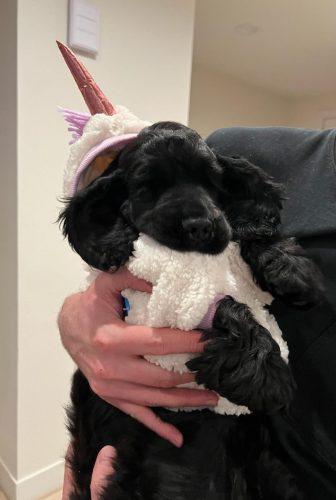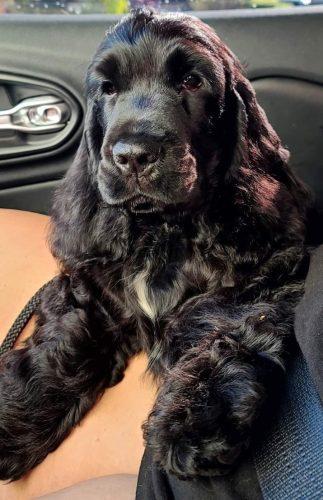We hope to have two or three litters this year. We will be having our first parti colored litter this spring!
We have a four year old, neutered black male that needs his forever home. If interested please contact me…..
Make sure you read the article below the photos!
One might ask,” is the English Cocker right for me”?
The answer, for the most part, is a resounding “yes”!
This is a breed that suits virtually any lifestyle or household, within certain parameters.
The English Cocker is a versatile, biddable character that tends to make their owners very happy… They can be content snoozing on the sofa or out running in the field, dock diving, swimming, doing agility, hiking and more. They make wonderful therapy dogs for visiting nursing homes and also make excellent “hearing ear” or “sniffer” dogs. They are eager hunting companions, ready to bustle through thick brush to flush birds and can retrieve even a pheasant with a very soft mouth. For those not predisposed to that type of activity, be aware that a walk for an English cocker is not always about a chance to relieve themselves, but to stop and sniff, and sniff and sniff all the wondrous odors of the outdoors. Indeed taking a fast walk with an English cocker may prove a bit challenging, as they may be on the lookout for the neighborhood critters, often losing themselves in a hedge or bush in the process.
They are a breed that is very food-motivated, which makes them easy to train, but also they can be a bit goofy or stubborn and may take a bit longer to house train. They generally love people, although some can be a bit aloof, warming up to folks only once they’ve had a more lengthy introduction. It is because they so love to be with their people that they may be more prone to separation anxiety, and why owners may find they are seldom alone, especially in the bathroom or kitchen. English cockers are wonderful dogs for children and are quite tolerant, within reason, of hugs, pokey little fingers, and high pitched squeals. Whether they truly love children and see them as equals or just know they always smell like or are dropping food, may remain a mystery.
As positive as being food-motivated can be, it is often what gets these guys in trouble. Yet is difficult to be angry with a wayward one, because they will invariably be happy to display the trash they just got into or the food wrappers whose contents they’ve just consumed. Seeming to be ALWAYS hungry they can be prone to counter surf, somehow snatching food items that you felt were quite out of their reach. Some have even climbed on chairs and tables to land their prey.
Trash, especially tissues or food scented items, or clean rolls of toilet paper also seem to be favorite items, so waste-bins must be securely closed. When not eating, they often will be holding something, whether a stuffed toy, a tennis ball or maybe your favorite sock. English cockers will act like puppies through much of their lives, but mental maturity seems to click in at age two.
Although English cockers come in over 20 color patterns and combinations, the most common is blue roan. Roan is a term that describes the mixture of white hair with the dominant color, and “blue” is a white dog with black patches with white and black hair mixed (the roaning). An orange roan would be a white dog with orange patches and orange hair mixed with white. Ticking is like freckles of the dominant color, and so, an orange and white ticked dog would be white, with patches of orange, and scattered spots.
Dogs without ticking are just “black and white ” or “orange and white” etc. Solid colored English cockers are black, red (more like shades of gold) and black and tan, like a Gordon setter, and liver. Roans can also be liver and are very pretty, but much harder to find because it is a recessive color.
Wait… there’s more! All of the above colors can also come with tan accents, so one can see a blue roan and tan, where the tan points are over the eyes, on the feet, under the tail, etc. Sable is a hard color to describe; it is a controversial color in that it is not officially recognized in our standard, although the fans of this color are quite devout. A lemon-colored dog is very pale orange with different pigment…and very rare.
The important thing to know is that all English cockers have the same personalities regardless of color. Owners of dogs with the tan points (black & tan, blue roan & tan, etc…) seem to agree that they may be a little more devilish but in a cute way. The main difference personality-wise comes between the sexes. Despite the stereotype, the male English cocker is generally the soft, sweet, doofus which tends to be more cuddly and playful while the females will demand attention when they need it but are otherwise more independent. It is often much easier to have two male dogs in the same household than two females. A breeder who watches the pups grow up will be able to distinguish their personalities and will make every effort to pair a prospective owner with a dog that best suits them. For example, they will know which pup is more docile and which more adventuresome, etc.
In terms of grooming, while ECS certainly do shed, pets can be shaved down with fringe left on their ears, legs, and body as desired. Expect to need a grooming appointment every 8 weeks. Darker colored dogs tend to grow more coat, and spayed females’ coats can sometimes be coarse and matt more easily. Otherwise, their hair is typically soft and silky. Routine ear cleaning is important, especially keeping the inner flap of the ear and ear canal clear of hair. Some dogs can get lip fold infections. Your dog’s ears fringe will get wet and dirty. If your dog will wear a “snood”, which is a sleeve of cloth that holds their ears back while eating, that will help minimize this problem, but do expect wet ears (and maybe a wet floor) after they’ve had a drink. If paws are not kept trimmed, rainy days will result in more puddles and muddy paw prints.
English cockers typically enjoy a life span of 12-14 years. The responsible preservation breeder will screen their breeding stock for an eye disease, called PRCD, which causes blindness in older dogs, as well as screen for hip dysplasia, and, in solid dogs, AON, a degenerative neurological condition that leads to an unsteady gait in adults. FN, a kidney disease that is fatal in very young dogs is another problem being prevented by genetic screening. Other breeders go further, checking for thyroid issues and other orthopedic problems as well as deafness. That said, not all of these disorders can be prevented.
Other not uncommon issues, seen in about 3-5 % of dogs are allergies, immune hemolytic anemia and/ or thrombocytopenia, irritable or inflammatory bowel disease, epilepsy, disc disease, megaesophagus, Addison’s disease, anal sac carcinoma, and urinary crystals or stones. One’s best guide is to work with a breeder that will be honest about things that have been in their lines, especially recently, and especially about things that might show up at a younger age. While this list may seem daunting, breeders are to be commended for funding research into the many types of disorders that might befall their breed, always searching for ways to predict and avoid such issues as well as keeping track of their incidence and prevalence.
Written by: Marsha T. Wallace, MD, Honorary Member ECSCA






